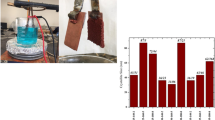Abstract
This paper is concerned with studying the effect of electrolyte characteristics on the production process of electrolytic copper powder from partially depleted Cu containing synthetic electrolytes by electrowinning technique. The main electrolyte characteristics are temperature, circulation rate, Cu and H2SO4 concentrations, residence time in the cell, and utilization of organic bath additives. The process is positively affected by increasing the values of all of the studied parameters except for the addition of organic bath additives, which causes a negative effect. However addition of organic bath additives remarkably increases the degree of refinement of the produced powders. In most cases pure and fine copper powders were obtained with a dendritic shape, as indicated by scanning electron microscope (SEM) analysis.













Similar content being viewed by others
References
Subbaiah T, Das S (1989) Physico-chemical properties of copper electrolytes. Metall Trans B 20B:375–380
Price D, Davenport W (1981) Physico-chemical properties of copper electrorefining and electrowinning electrolytes. Metall Trans B 20B:639–643
Gladysz O, Los P, Krzyzak E (2007) Influence of concentrations of copper, leveling agents and temperature on the diffusion coefficient of cupric ions in industrial electro-refining electrolytes. J Appl Electrochem 37(10):1093–1097
Moats M, Hiskey J, Collins D (2000) The effect of copper, acid, and temperature on the diffusion coefficient of cupric ions in simulated electrorefining electrolytes. Hydrometallurgy 56:255–268
Fabricius G, Sundholm G (1985) The effect of additives on the electrodeposition of copper studied by the impedance technique. J Appl Electrochem 15:797–801
Suchkov A, Vorob’eva A, Kryzhova V et al (1987) Effect of electrolyte composition and current density on the particle size of electrolytic powders. Powder Metall and Metal Ceram 26(6):431–433
Alfantazi A, Valic D (2003) A study of copper electrowinning parameters using a statistically designed methodology. J Appl Electrochem 33:217–225
Xue J, Wu Q, Wang Z et al (2006) Function of additives in electrolytic preparation of copper powder. Hydrometallurgy 82:154–156
Muresan L, Nicoara A, Varvara S et al (1999) Influence of Zn2+ ions on copper electrowinning from sulfate electrolytes. J Appl Electrochem 29:719–727
Ettel V, Gendron A, Tilak B (1975) Electrowinning copper at high current densities. Metall Trans B 6B:31–36
Agrawal A, Kumari S, Bagchi D et al (2007) Recovery of copper powder from copper bleed electrolyte of an Indian copper smelter by electrolysis. Miner Eng 20:95–97
Burgess DP, Gort WM, Haines RK et al (1995) Process for making copper metal powder, copper oxides and copper foil. US Patent 5,458,746, issued on 17 Oct 1995
Moats M, Free M (2007) A bright future for copper electrowinning. JOM 59(10):34–36
Owais A Effect of material and shape of starting cathodes on electrowinning of copper powder, under publication in December 2007 at Journal of faculty of Petroleum and Mining Engineering. Suez Canal University, Egypt
Andersen T, Adamson D, Richards K et al (1974) The corrosion of lead anodes in copper electrowinning. Metall Trans B 5(6):1345–1349
Karavasteva M (2005) Kinetics and deposit morphology of copper cementation onto zinc, iron and aluminum. Hydrometallurgy 76:149–152
Dönmez B, Sevim F, Saraç H (1999) A kinetic study of the cementation of copper from sulphate solutions onto a rotating aluminum disc. Hydrometallurgy 53(2):145–154
Russev D (1981) An electron microscope investigation of electrolytic copper powders. J Appl Electrochem 11:177–185
Nikolić N, Pavlović L, Pavlović M et al (2008) Morphologies of electrochemically formed copper powder particles and their dependence on the quantity of evolved hydrogen. Powder Technol 185:195–201
Owais A (2003) Packed bed electrolysis for production of electrolytic copper powder from electronic scrap. Ph.D. Thesis, RWTH-Aachen, Germany, pp 95–96
Acknowledgements
The author wishes to express his gratitude to all staff members of the Institute of Nonferrous Metallurgy, Montan University Leoben, Austria, for their assistance and help in carrying out the experimental work. Many thanks are also due to The Austrian Exchange Service (OeAD), Austria and the Ministry of Higher Education and Scientific Research, Egypt, for financing the accommodation and living in the period of research.
Author information
Authors and Affiliations
Corresponding author
Rights and permissions
About this article
Cite this article
Owais, A. Effect of electrolyte characteristics on electrowinning of copper powder. J Appl Electrochem 39, 1587–1595 (2009). https://doi.org/10.1007/s10800-009-9845-y
Received:
Accepted:
Published:
Issue Date:
DOI: https://doi.org/10.1007/s10800-009-9845-y




